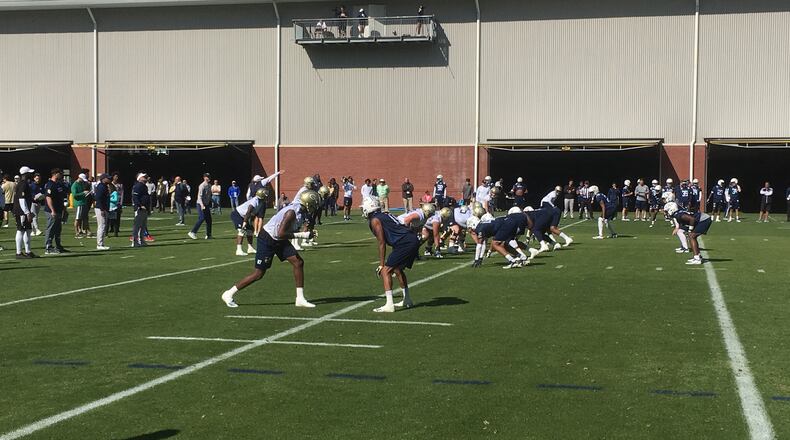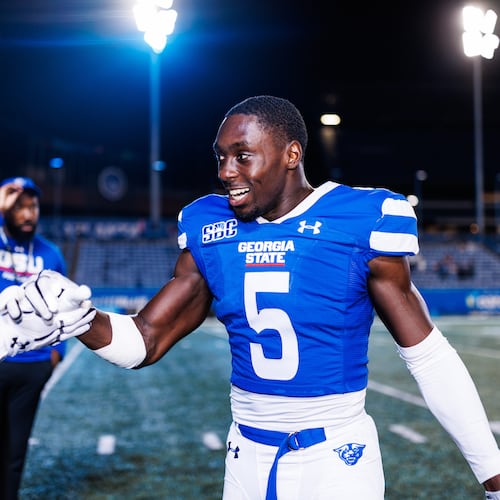The first clue that practice at Georgia Tech had undergone some changes was the music. Participants at the Yellow Jackets’ second spring-practice session Thursday were treated to hip-hop music, such as Kodak Black’s Zeze, as the team went through its workout.
“I love it,” said quarterback James Graham, who added that players were given the chance to make requests earlier in the spring. “It energizes me and pushes us, turns us up.”
But other symbols of metamorphosis of this team as it goes through its first spring practice with coach Geoff Collins after former coach Paul Johnson’s 11-season tenure weren’t difficult to miss. One was the time of the practice – before noon, and ending at 11 am. With Johnson, practices ran in the late afternoon.
“It’s just great,” Collins said. “We go ahead and get in, we get to work and then they’ve got the rest of the day to day academics, do study hall, those kind of things.”
Perhaps the most obvious was the change in the offense from Johnson’s spread option to offensive coordinator Dave Patenaude’s spread.
Quarterbacks Lucas Johnson, Tobias Oliver and Graham took snaps out of the shotgun. The offensive linemen, rather than taking stances where their weight distribution was forward to enable quick surges across the line of scrimmage, instead took three-point stances with their weight more evenly distributed. The offensive tackles lined up a shade off the line in a two-point stance – not an element of the Paul Johnson offense – the better to retreat and form a pocket.
Patenaude said the line has done a lot of growing in the first two practices, “understanding how to set (for pass protection), how to be patient, not to try to knock somebody back on pass pro, but to let the pass pro come to him, so their development is going to be over the course of the spring.”
The formations and plays were a change. Gone was the staple triple-option in favor of zone reads. The Jackets offense aligned with three wide receivers, sometimes flexing out a tight end (also new) for a four-wide look. Out of the shotgun, two backs sometimes flanked the quarterback.
“I ran an offense similar in high school, so learning that playbook now, I kind of referred back to what I did in high school as far as learning plays and footwork and everything, so I’m picking it up pretty fast,” Oliver said.
Inside the offensive huddle, the terminology was more expansive. Oliver said it was more challenging, but fun to learn.
“There’s a lot you’ve got to say pre-snap,” Oliver said.
Back to the tight end, a position that didn’t exist in the Johnson offense but is an integral piece of Patenaude’s scheme. Grad-transfer Tyler Davis flared out to catch a pass. Tyler Cooksey, previously a linebacker, also took snaps at the position. Walk-on Josh Tukes, also a linebacker last season, also is getting a look there. Players such as Cooksey and Tukes were scoped out during offseason workouts, as coaches looked for players whose body types fit the position. (Tukes is 6-foot-6 and 215 pounds, while Cooksey is 6-2, 232.)
“I don’t know if Tyler (Cooksey)’s going to run down the field and catch a bender (route) against Clemson, but he’s tough, he can run, he’ll hit people and he can catch the ball out of the backfield, do some naked (bootleg) stuff,” Patenaude said.
And, then, the succession of passes as the Jackets ended practice with a series of 11-on-11 plays. All three quarterbacks looked more than capable, finding downfield targets with tight spirals.
“The misconception is that these are quarterbacks who are run guys who can’t throw,” Patenaude said. “If you watched our practices the last two days – that’s a fallacy.”
Said Graham, “I love throwing the ball, yes, sir.”
Patenaude brought up a play from the first practice Tuesday. Oliver called out a change in pass protection before the snap, then after the snap went through his progressions on the left side of the play, didn’t like his choices, stepped up in the pocket and scanned right and completed a pass down the seam for about a 25-yard gain against tight coverage.
“That just doesn’t happen if you can’t throw and you’re not a really good player,” Patenaude said.
And, from the judgment of players, the energy level of the practice had changed. This isn’t to say players loafed around with Johnson, but the approach might have been more methodical.
“There’s so much energy,” Oliver said. “It’s like practice goes by in an hour. We’re out here for almost 2-1/2 hours, but it goes by, it seems like, in an hour with all the energy. I love it.”
Perhaps the most conspicuous symbol of the new era arrived after the final play of the practice, when linebacker Quez Jackson picked up a fumble and raced to the end zone, then continued his run back onto the field of play, flanked by celebrating teammates.
That might not have been different. After that, though, as the team circled around Collins to end practice, someone rolled out a gold beach cruiser, and Jackson hopped on and went for a ride around the field as his defensive teammates cheered their approval.
It's a turnover bike, Oliver explained, in the vein of Miami's turnover chain and other such novelties that have proliferated in college football. Or, as it was dubbed in a tweet from Thacker, the "Takeaway Cruzer," a one-speed with red tires with a face mask attached below the handlebars.
One can reasonably assume that it was not a leftover tradition from the Johnson regime.
About the Author
Keep Reading
The Latest
Featured


